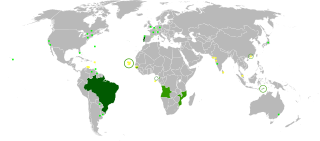
Portuguese is a Romance language originating in the Iberian Peninsula of Europe. It is the sole official language of Portugal, Angola, Mozambique, Guinea-Bissau, Cape Verde, São Tomé and Príncipe, and Brazil, while having co-official language status in East Timor, Equatorial Guinea, and Macau. A Portuguese-speaking person or nation is referred to as "Lusophone". As the result of expansion during colonial times, a cultural presence of Portuguese and Portuguese creole speakers are also found around the world. Portuguese is part of the Ibero-Romance group that evolved from several dialects of Vulgar Latin in the medieval Kingdom of Galicia and the County of Portugal, and has kept some Celtic phonology in its lexicon.

Castile and León is an autonomous community in north-western Spain.
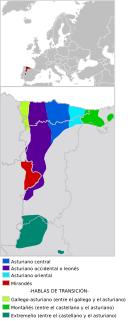
Asturleonese is a Romance language spoken primarily in northwestern Spain, namely in historical regions and Spain's modern-day autonomous communities of Asturias, northwestern Castile and León and Cantabria. The name of the language is largely uncommon among its native speakers, as it forms a dialect continuum of mutually intelligible varieties and therefore it is primarily referred to by various regional glossonyms like Leonese, Cantabrian, Asturian or Mirandese. Extremaduran is sometimes included as well.

Salamanca is a province of western Spain, in the western part of the autonomous community of Castile and León. It is bordered by the provinces of Zamora, Valladolid, Ávila, and Cáceres, and on the west by Portugal. It has an area of 12,349 km² and in 2018 had a population of 331,473 people. It is divided into 362 municipalities, 11 comarcas, 32 mancomunidades and five judicial districts. Of the 362 municipalities, more than half are villages with fewer than 300 people.
The Colonia Tovar dialect, or Alemán Coloniero, is a dialect that is spoken in Colonia Tovar, Venezuela, and belongs to the Low Alemannic branch of German.

Mozarabic, also called Andalusi Romance, was a continuum of related Romance dialects spoken in the Muslim-controlled areas of the Iberian Peninsula, known as Al-Andalus. Mozarabic descends from Late Latin and early Romance dialects spoken in Hispania up to the 8th century and was spoken until around the 13th century when it either was replaced or merged with the northern peninsular Romance varieties, mostly Spanish (Castilian), Catalan and Portuguese.

Extremaduran is a group of vernacular Romance dialects, related to the Asturleonese language, spoken in Extremadura and adjoining areas in the province of Salamanca. It is difficult to establish the exact boundary between Extremaduran and the Spanish varieties spoken in most of Extremadura.

Lusophones are peoples and nations that comprise an estimated 270 million people spread across 10 sovereign states and territories that recognize Portuguese as an official language. This area, known as Lusofonia or the Lusophone world, is the corresponding community of Lusophone nations which exist in Europe, the Americas, Africa, Asia, and Oceania.

Iberian federalism, pan-Iberism or simply Iberism are the names for the pan-nationalist ideology supporting the federation of all the territories of the Iberian Peninsula.

Leonese is a set of vernacular Romance language varieties currently spoken in northern and western portions of the historical region of León in Spain and a few adjoining areas in Portugal. In this narrow sense, Leonese is distinct from the dialects grouped under the Asturian language. There is no real linguistic division, though; it is only a purely political and identitary division, as dialectal areas are in fact shaped along a north-south axis, following the migration of population from north to south during the Middle Ages (Reconquista). In the past, it was spoken in a wider area, including most of the historical region. The current number of Leonese speakers is estimated at 20,000 to 50,000. The westernmost fringes of the provinces of León and Zamora are in the territory of the Galician language, although there is dialectal continuity between the linguistic areas.

The languages of Spain, or Spanish languages, are the languages spoken in Spain.
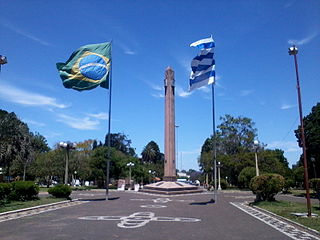
Uruguayan Portuguese, also known as fronteiriço and Riverense, and referred to by its speakers as portunhol, is a variety of Portuguese with heavy influence from Rioplatense Spanish. It is spoken in north-eastern Uruguay, near the Brazilian border, mainly in the region of the twin cities of Rivera (Uruguay) and Santana do Livramento (Brazil). This section of the frontier is called Frontera de la Paz, because there is no legal obstacle to crossing the border between the two countries.

Portuguese is the official and national language of Brazil and is widely spoken by most of the population. The Brazilian Sign Language also has official status at the federal level.
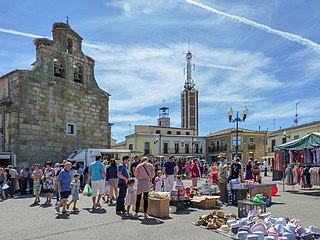
La Fuente de San Esteban is a village and large municipality in the province of Salamanca, western Spain, part of the autonomous community of Castile-Leon. It is located 54 kilometres (34 mi) from the provincial capital city of Salamanca and has a population of 1,358 people.

Fuentes de Oñoro is a village and municipality in the province of Salamanca, western Spain, part of the autonomous community of Castile-Leon. It is located 124 kilometres (77 mi) from the provincial capital city of Salamanca, and has a population of 1058 people. It was the site of a significant battle in 1811, during the Peninsular War.
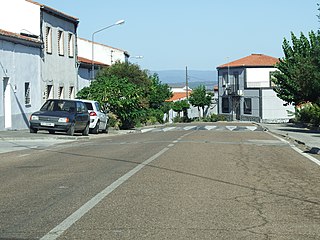
Cedillo is a town and municipality in Spain, located in the province of Cáceres, community of Extremadura. According to the 2008 census (INE), the municipality has a population of 518 inhabitants.

Salamanca is a city situated in western Spain and is the capital of the Province of Salamanca in the autonomous community of Castile and León. The city lies on several rolling hills by the Tormes River. Its Old City was declared a UNESCO World Heritage Site in 1988. As of 2018, the municipality has a population of 143,978.
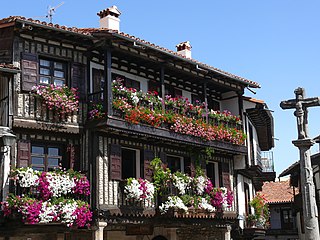
La Alberca is a municipality in the province of Salamanca in the autonomous community of Castilla y León, Spain. It is the capital of Sierra de Francia Comarca.

Equatorial Spanish, also called Coastal Colombian-Ecuadorian dialect or Chocoano, is a dialect of Spanish spoken mainly in the coastal region of Ecuador, as well as in the bordering coastal areas of northern Peru and southern Colombia. It is considered to be transitional between the Caribbean dialects and the Peruvian Coast varieties. The major influential linguistic centers are Guayaquil and Buenaventura. There is an important subvariety of this dialect which is spoken by most of the communities of African descent dwelling on the border between coastal Colombia, Ecuador, and Peru, and which is said to reflect African influence in terms of intonation and rhythm.



















